Red Bull’s crushing start to the 2024 F1 season that ended in a cloud of smoke
The Max Verstappen juggernaut rolled on in the 2024 Bahrain and Saudi Arabian GPs before coming to a juddering halt in Australia. Mark Hughes reports on 2024’s opening rounds
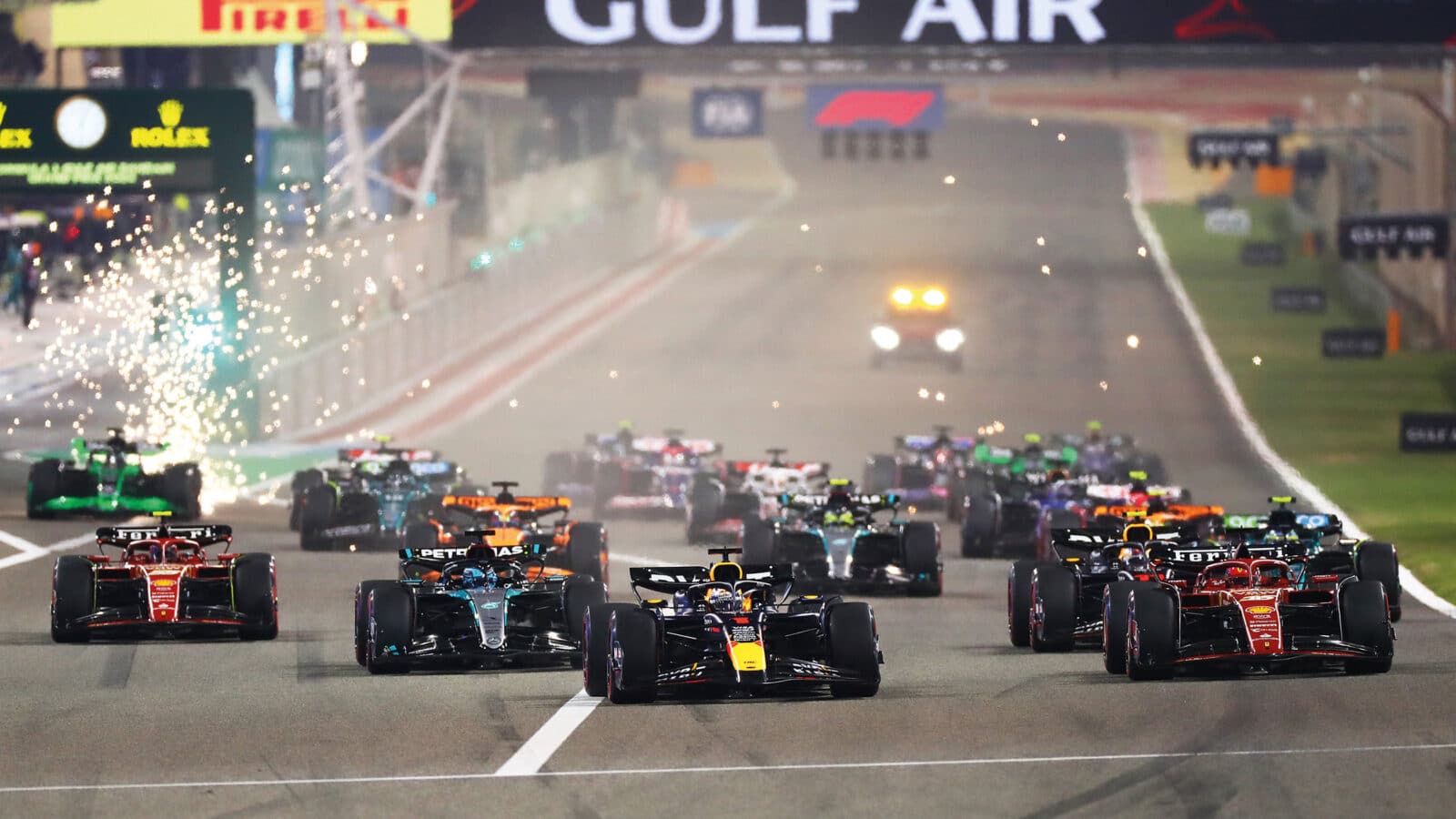
And they’re off – with Max Verstappen leading the charge at the start of the Bahrain GP.
Getty Images
Meet the new season, same as the old one. Max Verstappen’s Red Bull totally dominant, Charles Leclerc giving spirited chase in his Ferrari, Mercedes struggling with bouncing, McLaren in that second group but still suffering difficulties in slow corners, Aston Martin in a no-man’s land between the lead group and the lower half.
Recall when Verstappen broke the record for consecutive grand prix victories by scoring his 10th in a row at Monza last year? Recall how Carlos Sainz had brought that run to an end in Singapore, and how Verstappen had to start all over again if he was to ever extend beyond 10? Well, by the eve of this season, he was already up to seven. If he could win the opening three races, in Bahrain, Saudi Arabia and Australia, he’d be on 10 again already. It had taken someone 70 years to break Alberto Ascari’s record, yet Verstappen stood on the precipice of achieving it only a matter of months after first doing so. Pre-season testing suggested it would likely happen.
The hope given by both Ferrari and Mercedes having abandoned their dead-end concepts of last year seemed to have been dashed by Red Bull having moved the game on with its RB20 design. But the flawless performances on track were in stark contrast to the turbulence inside a team which seemed to be tearing itself apart and maybe that is the only sliver of hope for the competition.
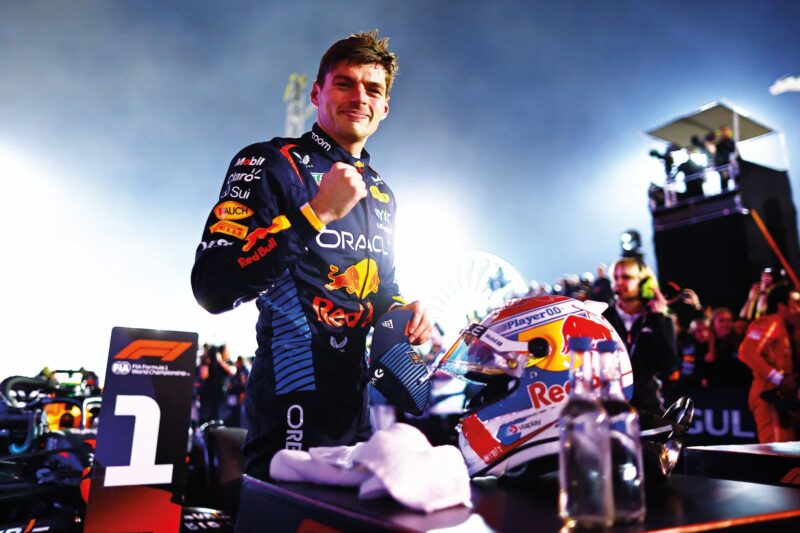
Race winner Verstappen – still No1
Verstappen took pole for the season-opener in Bahrain but might not have done had things gone more smoothly for Leclerc. His Q2 time was marginally faster than Verstappen’s pole but he couldn’t repeat it in Q3. He lost the rhythm, he said, after being obliged to do his first Q3 run on used tyres, only switching to a new set on the improving track for the final run. “You don’t know exactly how much front flap to have, you haven’t found the latest braking points,” he explained. “I just lost the rhythm. I’m not very happy.” He’d used up the extra new set in Q1 after a first lap deemed by the team as not safe enough to get through (it later turned out it would have been). He’d questioned the decision even as he was in the pitlane for that second Q1 run, but had he run his first lap more aggressively (as team-mate Carlos Sainz had done) it wouldn’t have been a point of discussion. Partly responsible for his fate, he was therefore irritated to qualify only second, ahead of George Russell’s Mercedes, Sainz, Sergio Pérez (Red Bull), Fernando Alonso’s Aston Martin, the McLarens of Lando Norris and Oscar Piastri and only then Lewis Hamilton.
“Sainz was 25sec behind the victorious Verstappen at the flag”
But no one, not even Ferrari, believed that Leclerc’s potentially fastest qualifying time suggested he’d be the quickest in the race. Testing the previous week and the practice days of the race weekend showed the Red Bull was much the fastest over a race stint. Just as last year, its advantage balloons when tyre degradation is part of the equation. It’s something baked into the car’s DNA, going back to the first year of these regulations.
Verstappen’s cruise to victory was made even easier by the brake problems afflicting both Ferraris, but particularly that of Leclerc. The chosen cooling level had proved to be inadequate and in addition there was a temperature imbalance across the front axle causing Leclerc’s car to pull hard right whenever he braked. He was soon passed by Russell but the Mercedes then began suffering from an overheating power unit – the chosen bodywork cooling levels proving optimistic – allowing even the troubled Leclerc to repass. Once Sainz had also passed Russell he was able to catch and pass his team-mate (and would do so again after Leclerc had undercut back ahead at the stops), with Pérez going on to pass them all to give Red Bull a 1-2. Sainz was able to keep the pressure on Pérez but was 25sec behind the victorious Verstappen at the flag.
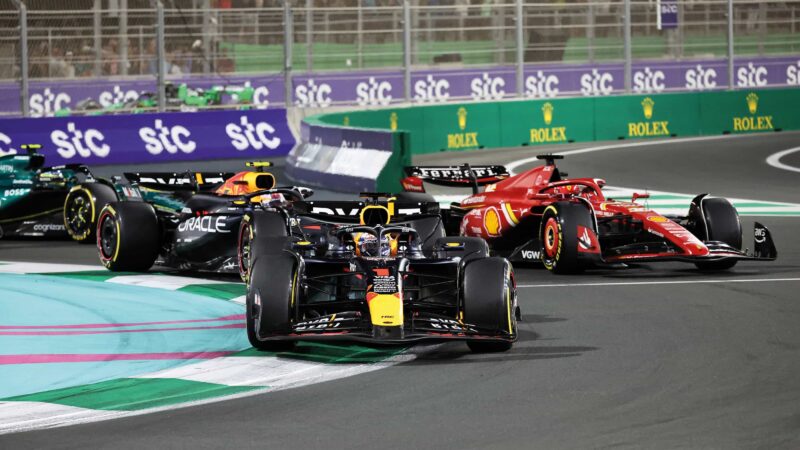
Charles Leclerc kept the two Red Bulls apart at the start of the Saudi Arabian GP.
Grand Prix Photo
The demands of the fast Jeddah track – once described as “Silverstone with walls” – were very different to those of Bahrain’s Sakhir circuit. In Saudi the tyre loading is much more evenly split between the front and rear and tyre degradation is much less of an issue. So that aspect of Red Bull’s superiority would be less heavily rewarded here in theory. That may have given Ferrari some hope, but it was evident early in the weekend that something was amiss with Sainz. He did FP1 and FP2 with a raging temperature and hoped a night’s sleep would see him ready for FP3 and qualifying the next day. He woke up in such pain he realised he needed to go to hospital, where an appendectomy was performed. Which is how 18-year-old Oliver Bearman made his F1 debut with Ferrari, having just set pole for the F2 support race, see panel.
“But what was this? The Ferrari slipstreamed past at over 160mph”
High-speed downforce is heavily rewarded here, especially in the first sector where the bends are fast but not quite flat-out kinks. With this set of demands the Red Bull’s qualifying performance was greater than that of Bahrain but its race day advantage was reduced slightly. The outcome was another 1-2, but Verstappen’s advantage over the best non-Red Bull (Leclerc) was this time ‘only’ 18sec. The fact that Pérez could comfortably defeat Leclerc despite a 5sec penalty incurred for an unsafe release from his pitstop confirmed the extent of Red Bull’s superiority.
There was a very distinct car performance hierarchy around Saudi: Red Bull, Ferrari, McLaren, Aston Martin, Mercedes very much in that order. Piastri took fourth but would have been closer to Leclerc had he not been so long delayed behind the long-running but slow Mercedes of Hamilton. The McLaren’s slow end-of-straight speed meant even DRS wasn’t enough to get it past the fast-on-the-straight Merc. Lando Norris and Hamilton ran in tandem pretty much throughout, having both stayed out on lap seven when a safety car (for a Lance Stroll accident) saw almost everyone else pit and fit hard tyres on which to get to the end. Norris and Hamilton were hoping for a late safety car to rescue their long-running strategy but it never came. So they rejoined on their fresh soft tyres catching the seventh place rookie Bearman on his old hard rubber. He was running a few seconds behind Alonso’s Aston and Russell’s Mercedes and running similar lap times. As the two fresher-tyred cars began catching him, he asked his engineer how hard he could push the tyres. Riccardo Adami replied he should just press on, the tyres would be fine. Impressively, Bearman responded by lowering his lap times by around half-a-second, enough to keep Norris and Hamilton off his back. It was an extremely assured debut.
Save for a few anxious moments lapping backmarkers on his old tyres, Verstappen’s pulse rate was probably well under control as he took his ninth consecutive GP victory, the only driver in history to have done so twice.
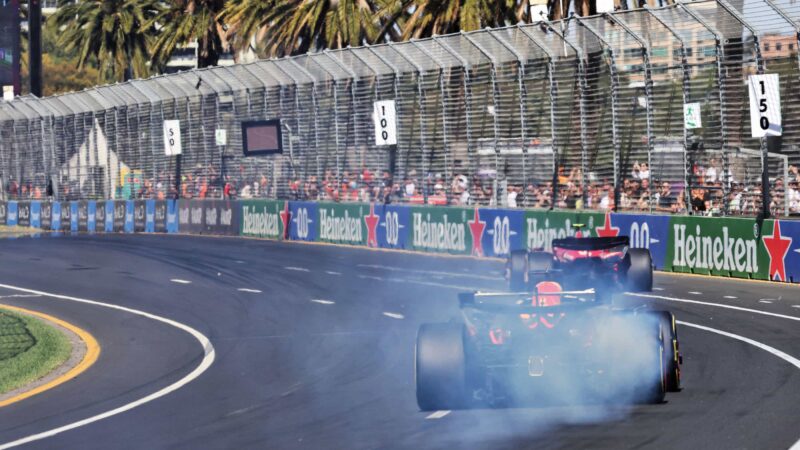
Smoke from Verstappen’s brake at Albert Park -he’d soon retire
Alamy
Verstappen was again threatened by Ferrari for pole around Albert Park, but this time by Sainz rather than Leclerc. This was an impressive performance from someone who had been under the surgeon’s knife just a few days earlier. “It’s not painful,” he reported of the physical challenge. “It just feels a bit weird because everything inside you is moving about more in the high-g corners and under braking.” His final Q3 lap was absolutely level with Verstappen’s until a snap of seventh gear oversteer at the 160mph Turn 9-10 lost him 0.4sec. He clawed back around 0.15sec of that in the remainder of the lap but it was another pole for Verstappen, with Sainz alongside.
That surely was going to be the foundation for the record-equalling 10th consecutive victory. It even looked like that at the start as the Red Bull surged straight into the lead and pulled out 1sec on the Ferrari on the opening lap. But what was this? Verstappen running wide over the Turn 3 exit kerbs on the second lap, Sainz looking ready to pounce. With a better run up the long fast stretch which follows and with DRS now in play, the Ferrari slipstreamed past at over 160mph, sweeping into the lead into that fast Turn 9-10 left-right. The crowd cheered. They did so even more as smoke began rising from the right-rear of the Red Bull and as Verstappen brought it into the pits to retire with the whole corner of the car ablaze, there was great excitement. A rear brake caliper had not released itself fully from the disc and overheated. Verstappen’s first DNF since this race two years ago. Someone other than Verstappen was going to win – and it looked like it was going to be Sainz again.
That’s exactly how it played out. Despite the discomfort from his operation he was fully in control, even more so as his initial pursuer, Norris’s McLaren, was undercut by Ferrari team-mate Leclerc at the first stops. McLaren used Norris and Piastri to return the undercut pressure on Leclerc up to the second stops but Ferrari had that covered – and Sainz eased ever-further clear.
“It was Verstappen’s first DNF since this race two years ago”
In contrast to the comfortable second places he delivered in the opening two races, Pérez was a distant fifth here, further suggesting that Red Bull did not have its usual superiority. Certainly, Sainz had the feeling that his Ferrari was genuinely competitive with the RB20 here where the challenge was all about controlling the tyre graining. Pérez had picked up a tear-off visor as he’d passed Alonso’s Aston Martin which lodged in the underbody of the Red Bull, costing 0.2sec of lap time for the race. Even before then he’d been on-course only to challenge the McLarens, not the Ferraris.
It was a woeful race for Mercedes, with Hamilton not making it through to Q3 and retiring from seventh place in the race with a power unit failure. Russell qualified seventh and was chasing Alonso for sixth into the race’s late stages when the Aston driver’s unusually early braking for Turn 6 caught Russell by surprise, causing him to run through the gravel trap and hard into the barriers, which flipped the Mercedes on its side as it rolled over its dangling wheel on its broken suspension. With the car in the middle of the track, the last lap was under virtual safety car conditions, Sainz taking the chequer for his third career victory, in his final season with Ferrari.
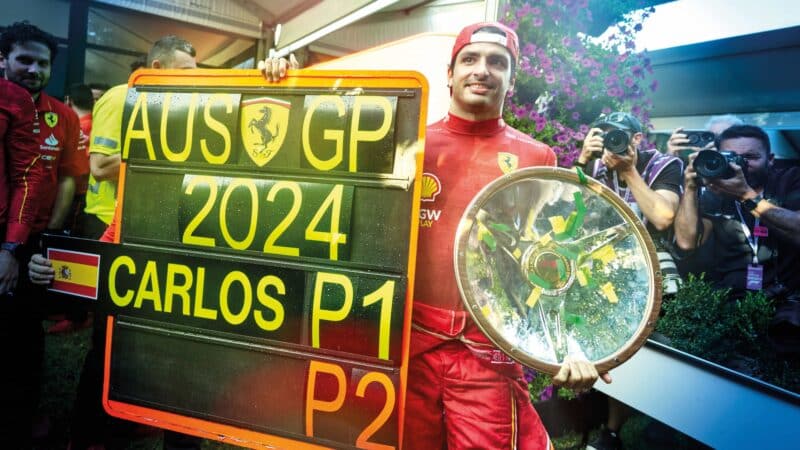
From sickbed to, as the young might say, a ‘sick’ performance – Carlos Sainz showed superb bounce back ability in Australia
The irony of the timing was not lost on him: “Life is strange sometimes… it’s not only the last two weeks, but the whole start to the year in general. How the year started with the news of the [contract] non-renewal, then you get yourself fit, you get yourself ready for the season. Pushing flat out, you go to Bahrain do a good podium, say, ‘OK now the season is starting well and I can keep the momentum going’ and then boom, missing a race in Jeddah, the operation, long days in bed, not knowing if I was going to be back in time. Obviously a lot of unknowns; am I going to be back fit? Am I going to be back feeling still good with the car? And then you come back and win. As I said on the radio, life is a rollercoaster sometimes but it can be really nice and good to you sometimes.”
